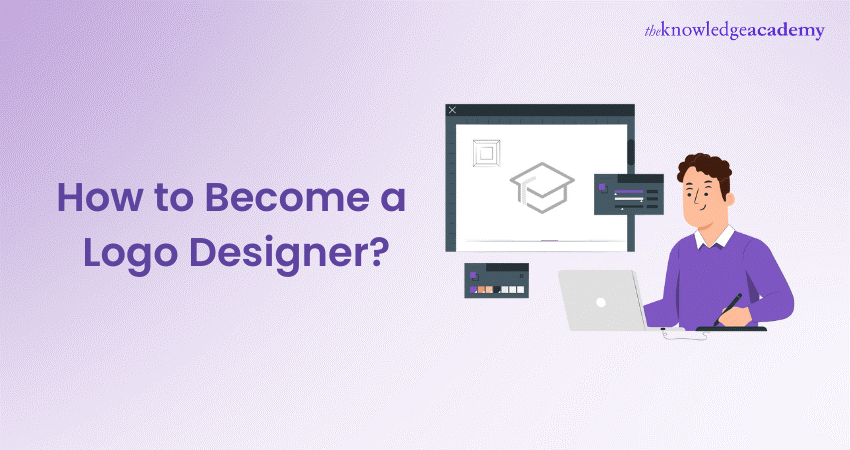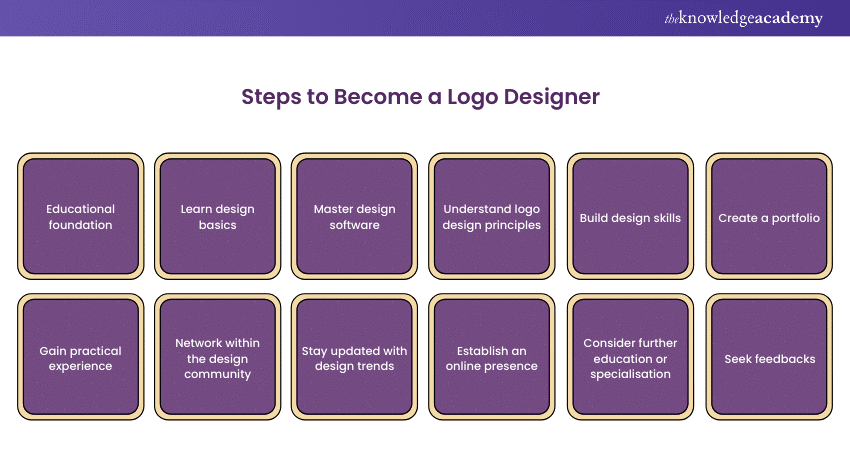We may not have the course you’re looking for. If you enquire or give us a call on 01344203999 and speak to our training experts, we may still be able to help with your training requirements.
Training Outcomes Within Your Budget!
We ensure quality, budget-alignment, and timely delivery by our expert instructors.

Embarking on the path to becoming a Logo Designer is a journey marked by creativity, strategic thinking, and a deep understanding of visual communication. In a world where brands seek to distinguish themselves, the role of a logo designer is pivotal in crafting identities that resonate with audiences and stand the test of time. In this blog, we'll provide a detailed, step-by-step guide on how to become a logo designer, including the essential resources and tools needed for this creative journey.
Table of Contents
1) Who is Logo Designer?
2) Steps to become a Logo Designer
3) Responsibilities of a Logo Designer
4) Conclusion
Who is Logo Designer?
A Logo Designer is a skilled professional dedicated to crafting unique visual symbols, or logos, which serve to represent and communicate the identity of a brand, company, product, or service. The role of a Logo Designer involves combining artistic and design skills to develop a visual mark that is not only aesthetically pleasing but also conveys the values, personality, and essence of the entity it represents.
Logo Designers work to create distinctive and memorable logos that can be easily recognised and associated with a particular brand. They often collaborate with clients to understand their vision, target audience, and brand messaging, translating these elements into a graphical representation. Logo Designers may use various design software, colour theories, typography, and other graphic design principles to craft logos that are versatile, scalable, and effective across different platforms and media.
Steps to become a Logo Designer
Becoming a Logo Designer involves a combination of education, skill development, practical experience, and building a strong portfolio. Here are the steps to guide you in becoming a Logo Designer:

Educational foundation:
a) Obtain a high school diploma or equivalent to lay the foundation for further education.
b) Think about obtaining a degree in graphic design, visual arts, or a similar discipline to acquire a formal education in design principles.
Learn design basics:
Understand fundamental design principles, including how colours interact, how to create balanced compositions, and the importance of typography.
Master design software:
Learn industry-standard design software like Adobe Illustrator and Photoshop to execute your design concepts effectively.
Ready to elevate your logo design skills? Join our Logo Design Training and master the art of creating impactful and memorable logos!
Understand logo design principles:
Familiarise yourself with the core principles of logo design, such as simplicity (keeping designs uncomplicated), scalability (maintaining clarity at various sizes), versatility (suitability for different applications), and memorability.
Build design skills:
Practice regularly to refine your artistic and creative skills. Experiment with various design styles to find your unique approach.
Create a portfolio:
Develop a portfolio showcasing a range of logo designs. Include diverse projects to demonstrate your versatility and ability to adapt to different design needs.
Gain practical experience:
Seek opportunities for practical experience through internships, freelance projects, or entry-level positions in design agencies. This hands-on experience is invaluable for applying theoretical knowledge in real-world scenarios.
Level up your artistry! Join our Drawing Masterclass for an inspiring journey into the world of creativity!
Network within the design community:
Join online and local design communities to connect with fellow designers. Participate in industry events and involve yourself in discussions to expand your professional network and gather insights from seasoned experts.
Stay updated with design trends:
Stay updated on contemporary design trends and emerging technologies in the field. This ensures that your work remains relevant and aligned with industry standards.
Establish an online presence:
Develop a professional website or portfolio to display your logo design work. Utilise social media platforms to share your designs and connect with potential clients or collaborators.
Ready to master design patterns? Elevate your skills with our Design Patterns Training. Register now for a transformative learning experience!
Consider further education or specialisation:
Evaluate the possibility of advanced education or specialising in a specific area of design based on your career goals. This could involve pursuing a master's degree or focusing on a niche within the design field.
Seek feedback and continuous improvement:
Welcome constructive criticism to enhance your skills. Actively seek feedback from peers, mentors, or online communities. Embrace a mindset of continuous improvement and stay curious about evolving design techniques and trends.
Dive into the world of digital art! Join our Digital Painting Masterclass and elevate your skills!
Responsibilities of a Logo Designer
The responsibilities of a Logo Designer encompass various aspects of creating visual identities that effectively represent a brand. Here are the key responsibilities:
1) Understand the client's needs: Conduct thorough discussions with clients to understand their business, values, and goals. Ask questions to gather information about the target audience and the message the client wants to convey.
2) Research and analysis: Research the industry, competitors, and current design trends to ensure the logo is distinctive and relevant. Analyse the client's brand positioning and target market to create a logo that resonates with the intended audience.
3) Conceptualisation: Develop multiple design concepts based on the gathered information and research. Create sketches or digital drafts to explore various visual ideas before refining the selected concepts.
4) Creativity and Innovation: Bring creativity and originality to the design process, aiming for a unique and memorable logo that stands out from the competition.
5) Typography and colour theory: Select appropriate fonts and typography that align with the brand's personality and message. Apply colour theory to choose a colour palette that conveys the desired emotions and aligns with the brand identity.
6) Versatility: Ensure that the logo is versatile and scalable, working effectively in various sizes and across different mediums, such as print and digital platforms.
7) Collaboration: Collaborate with other design professionals, such as graphic designers or marketing teams, to ensure consistency across all brand assets.
Ignite your creativity with Sketchbook Essential Training! Uncover the secrets to expressive sketching. Join now and bring your ideas to life!
Conclusion
In conclusion, the journey of How to Become a Logo Designer involves a combination of artistic flair, technical expertise, and effective communication. A Logo Designer's role extends beyond the creation of visually appealing graphics; it is about crafting a visual identity that resonates with a brand's essence and leaves a lasting impression on its audience.
Join our Animation and Design Training for a journey into the world of dynamic creativity!
Frequently Asked Questions
Upcoming Office Applications Resources Batches & Dates
Date
 Animation Course
Animation Course
Fri 3rd Jan 2025
Fri 7th Mar 2025
Fri 2nd May 2025
Fri 4th Jul 2025
Fri 5th Sep 2025
Fri 7th Nov 2025







 Top Rated Course
Top Rated Course



 If you wish to make any changes to your course, please
If you wish to make any changes to your course, please


